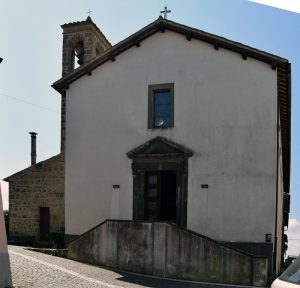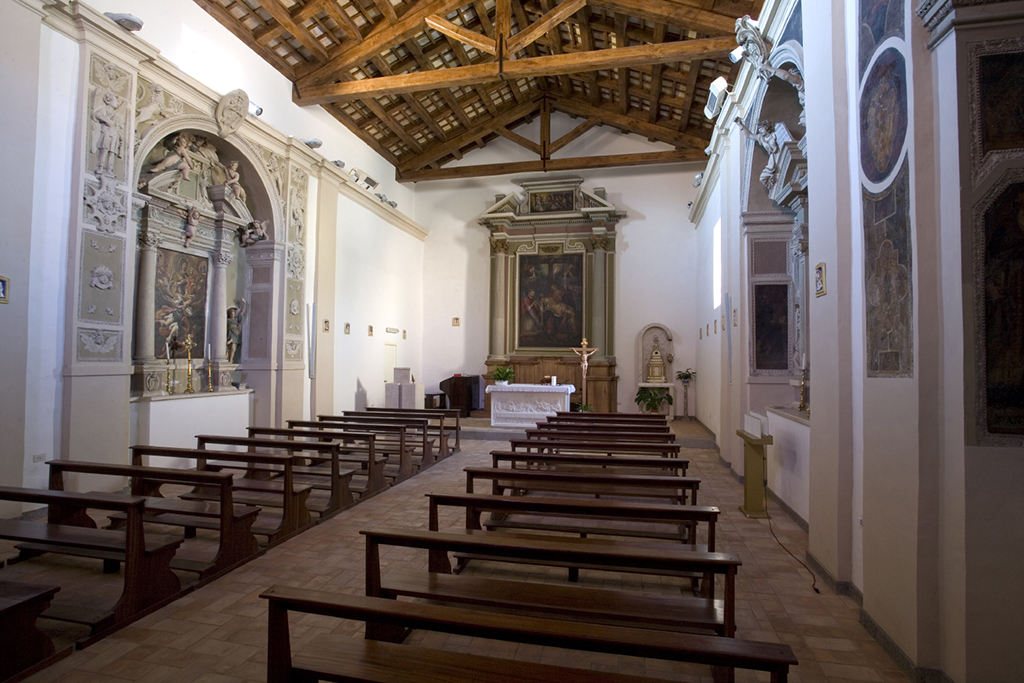- admin
- Nov, 09, 2024
- Places to visit
- Commenti disabilitati su 1. Church of San Carlo


Located in Piazza Umberto I, facing the walls of the hanging garden of the Rocca, the Church of San Carlo dates back to the early 17th century, when the Duchy of Castro, then governed by Duke Odoardo Farnese, significantly expanded its territory, leading to a substantial increase in the population of Capodimonte, which reached around 1,300 inhabitants.
At that time, the residents could only gather for prayer in a small chapel dedicated to Saint Roch, which Cardinal Laudivio Zacchìa described as “literally indecent!” during his visit in 1611. For this reason, at the initiative of the then-parish priest Don Giuliano Giuliani, with contributions from the Confraternity of the Most Holy Sacrament, the local population, and the Ducal Chamber, it was decided to build a new church dedicated to Saint Charles Borromeo, a saint cherished by the Farnese family. The main altar is dedicated to him and it is located at the end of the single nave; it features a large painting depicting Jesus being laid in the lap of the Madonna, assisted by Saint Charles.
There are also four other stucco altars characterized by decorative styles from the 17th century, each topped with the coat of arms of the family that erected it and featuring a painting of its patron saint at its center. The first altar on the right (starting from the entrance portal and moving counterclockwise) is dedicated to the Apparition of the Virgin to Saint Elizabeth and Saint Catherine of Alexandria (17th century). The second altar is dedicated to the Annunciation of the Virgin Mary (first half of the 18th century) and it is topped with a coat of arms likely belonging to Laudivio Zacchìa, who was then Bishop of Montefiascone (the same coat of arms can be seen on the portal of the former Bishop’s Palace, located to the right of the church, which was built by the Farnese and inaugurated by Bishop Zacchìa; it is now divided into private apartments).
The first altar on the left houses the most precious painting of the sanctuary, depicting the Madonna of Constantinople with the archangel Michael striking down the demon (17th century); it is noteworthy that the face of the demon has been scratched away by popular devotion. The altar is topped with a large coat of arms featuring the six Farnese lilies. The second altar on the left, as you return toward the entrance portal, is dedicated to Saint John the Baptist and the Baptism of Jesus (17th century) and prominently displays a cardinal’s coat of arms at its center.
On some of the side panels of the four lateral altars, frescoes from the 17th century can be seen, recently uncovered.
The entrance portal, crowned by a beautiful lava stone tympanum with an ancient dedication to Saint Charles, is adorned with bas-relief panels created by contemporary sculptor Mario Vinci, depicting various episodes from the life of Jesus. The upper stained glass window features an image of Christ Pantocrator along with the inscription “I am the light of the world,” crafted by German artist Martin Figura, who settled by Lake Bolsena and is known and appreciated for his works.
The church has a small bell tower with a square turret that houses two bells. When the first stone was laid on April 15, 1616, some medals belonging to Cardinal Alessandro were placed in the foundations to commemorate that the church was built not only with funds raised by the community but also thanks to significant support from the Farnese family. Several confraternities have been based in this church, associated with its four altars. Today, only the centuries-old Confraternity of the Most Holy Sacrament remains.